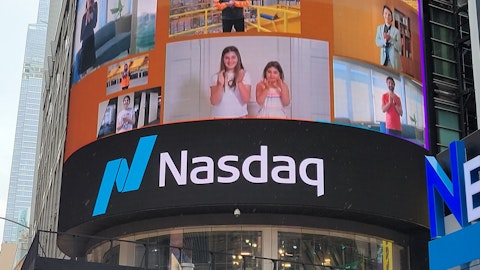Wa’el Hashad: Michael, let me add a couple of things to what – I think Nataliya has alluded to them briefly, one is the investigator meeting. We’re planning on doing an investigator meeting. That is, we believe, is an important step. As you hear from Nataliya, we’re adding four new sites. In order to accelerate this, we believe that one of the best mechanisms is to share some of the best practices from the sites that has been there. As you also know, that was a trial that has been going now for over 1.5 year, sometimes sites gets a fatigue. So we believe that the investigator meeting will be used to or utilized to reinvigorate the sites and the excitement around the study and enable us to complete. The last thing that I will add is that the team, also Nataliya’s team is working with advocacy groups and so on to increase the level of awareness among the patients.
I remind you that this is still a very small population. So it has all the challenges of rare diseases, but we are committed to, as I said, working with advocacy group and drive awareness about our trial and the work that we’re doing.
Michael Okunewitch: All right, thank you. And then just one last one for me and then I’ll hop back into the queue. So over the last couple of months, we have seen some activity from Mesoblast in HLHS, specifically some FDA designations in the publication back in December. So could you just, I guess, give us an idea of how the drugs stack up beyond Lomecel-B, obviously, being in a more advanced stage. Specifically, I guess, if there are any key differences in the signaling profiles that might provide a competitive advantage. And then further, given that you are in a potentially pivotal trial, does this provide some additional validation for stem cells as a modality in HLHS overall?
Wa’el Hashad: Nataliya, do you want to take a first stab on this one? I’m happy to add also from a competitive standpoint.
Nataliya Agafonova: Sure. The Mesoblast study in Boston Children Hospital, which was just published, even though involve keeps this with HLHS, it’s a different degree of HLHS, and they inject stem cells into the left ventricle. So they just basically try to regenerate left ventricle. So the severity of the – of those cases are slightly different. So even though is the competitor and it seems like the same disease is not. So the mechanism which we are trying to achieve, long-term survival and transplant-free survival, is injected into the right heart and to increase the right injection ventricle function, which is surrogate endpoint, post surrogate endpoint for the long-term great outcome. So again, it is the same disease, but the severity and the safety and the keys to this disease are slightly different. I hope I did address that part of the question. And Wa’el, maybe you can continue.
Wa’el Hashad: Yes. I would just add that I really – although it is very hard to speculate why Mesoblast made the decision. But I really believe that their approach is very different than our approach. We are there to go as an adjunct therapy to the current standard of care. We are on a much more advanced stage. And I also believe there could be also with the type of data that we have presented so far, that this is going to get more people to be excited about that view. But I do believe that we are ahead of them from the clinical development standpoint and even the possibility of validating our mechanism as well, Michael.
Michael Okunewitch: Yes. Thank you. That’s certainly extremely helpful.
Operator: Thank you. Our next question is from the line of Brad Sorensen with Zacks Research. Please go ahead.
Brad Sorensen: Yes, thank you. Good to talk to you guys and good presentation. I just wondered if I can get a little more color on the progress of the Alzheimer’s research, it seems like there have been some pretty positive results from that. And I just wondered if you were – you said you were looking for additional partners and funding. Is that on the back burner until you get that funding? Or are you going to continue the research while concurrently with looking for that funding? Just a little more color on that would be appreciated.
Wa’el Hashad: I’ll take that question. So Brad, we realized that advancing our work. First, I want to say that we are extremely excited and happy with the results that we have seen out of the CLEAR MIND trial. This Phase 2a have really showed, I would say, a signal that, that definitely getting everybody and we have reviewed this with thought leaders in the scientific community. And I think everybody agrees that further development and progress of this program and Alzheimer is warranted. And with that, we want to get into being more pragmatic and practical here. And there is a lot of – what are we doing? We are pursuing possibly a partnership, business through a business development opportunity or a partnership. We’re also evaluating.
There is a big, as you know, available public funding and private funding actually for that matter to support the development of medicines to treat Alzheimer’s disease. It is one of the biggest public health crisis that we have faced in recent years, and there is a lot of people who want to put money. So what we’re doing is we’re pursuing the two parallel paths, and we are trying to secure funding. We’re also doing a lot of analysis of our data and formulating our opinion of the possible design of the next trial and the progress. So we are not slowing down or not doing anything. But we’re definitely trying to do this in a very responsible and financially responsible and focus our resources on the areas where it brings the fastest and the greatest return on investment.
I have no doubt that we will continue developing our program for Alzheimer’s disease, and we’ll continue to do all the setup work that is needed. And we will vigorously pursue partnership and other sources of funding like non-dilutive funding and so on.
Brad Sorensen: Okay, thank you. Yes, yes, the positive results, and like you said, it’s a major problem in the United States. So I just wanted to – I think you should be able to find partners. So I just want to make sure we’re going to continue the progress that we’re seeing on that. So I appreciate it.

